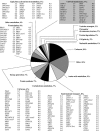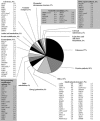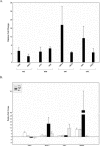Genome-wide expression profiling of the response to azole, polyene, echinocandin, and pyrimidine antifungal agents in Candida albicans
- PMID: 15917516
- PMCID: PMC1140538
- DOI: 10.1128/AAC.49.6.2226-2236.2005
Genome-wide expression profiling of the response to azole, polyene, echinocandin, and pyrimidine antifungal agents in Candida albicans
Abstract
Antifungal agents exert their activity through a variety of mechanisms, some of which are poorly understood. We examined changes in the gene expression profile of Candida albicans following exposure to representatives of the four currently available classes of antifungal agents used in the treatment of systemic fungal infections. Ketoconazole exposure increased expression of genes involved in lipid, fatty acid, and sterol metabolism, including NCP1, MCR1, CYB5, ERG2, ERG3, ERG10, ERG25, ERG251, and that encoding the azole target, ERG11. Ketoconazole also increased expression of several genes associated with azole resistance, including CDR1, CDR2, IFD4, DDR48, and RTA3. Amphotericin B produced changes in the expression of genes involved in small-molecule transport (ENA21), and in cell stress (YHB1, CTA1, AOX1, and SOD2). Also observed was decreased expression of genes involved in ergosterol biosynthesis, including ERG3 and ERG11. Caspofungin produced changes in expression of genes encoding cell wall maintenance proteins, including the beta-1,3-glucan synthase subunit GSL22, as well as PHR1, ECM21, ECM33, and FEN12. Flucytosine increased the expression of proteins involved in purine and pyrimidine biosynthesis, including YNK1, FUR1, and that encoding its target, CDC21. Real-time reverse transcription-PCR was used to confirm microarray results. Genes responding similarly to two or more drugs were also identified. These data shed new light on the effects of these classes of antifungal agents on C. albicans.
Figures





Similar articles
-
Genome-wide expression profiling of the response to polyene, pyrimidine, azole, and echinocandin antifungal agents in Saccharomyces cerevisiae.J Biol Chem. 2003 Sep 12;278(37):34998-5015. doi: 10.1074/jbc.M306291200. Epub 2003 Jun 24. J Biol Chem. 2003. PMID: 12824174
-
Stepwise emergence of azole, echinocandin and amphotericin B multidrug resistance in vivo in Candida albicans orchestrated by multiple genetic alterations.J Antimicrob Chemother. 2015 Sep;70(9):2551-5. doi: 10.1093/jac/dkv140. Epub 2015 May 27. J Antimicrob Chemother. 2015. PMID: 26017038 Free PMC article.
-
Changes in the proteome of Candida albicans in response to azole, polyene, and echinocandin antifungal agents.Antimicrob Agents Chemother. 2010 May;54(5):1655-64. doi: 10.1128/AAC.00756-09. Epub 2010 Feb 9. Antimicrob Agents Chemother. 2010. PMID: 20145080 Free PMC article.
-
[Antifungals cellular targets and mechanisms of resistance].Therapie. 2006 May-Jun;61(3):195-9. doi: 10.2515/therapie:2006048. Therapie. 2006. PMID: 16989119 Review. French.
-
Antifungal drug resistance in pathogenic fungi.Med Mycol. 1998;36 Suppl 1:119-28. Med Mycol. 1998. PMID: 9988500 Review.
Cited by
-
Whole genome sequencing of a clinical drug resistant Candida albicans isolate reveals known and novel mutations in genes involved in resistance acquisition mechanisms.J Med Microbiol. 2021 Apr;70(4):001351. doi: 10.1099/jmm.0.001351. J Med Microbiol. 2021. PMID: 33909551 Free PMC article.
-
Interaction of Candida albicans biofilms with antifungals: transcriptional response and binding of antifungals to beta-glucans.Antimicrob Agents Chemother. 2010 May;54(5):2096-111. doi: 10.1128/AAC.01638-09. Epub 2010 Mar 1. Antimicrob Agents Chemother. 2010. PMID: 20194705 Free PMC article.
-
Genomic insights into multidrug-resistance, mating and virulence in Candida auris and related emerging species.Nat Commun. 2018 Dec 17;9(1):5346. doi: 10.1038/s41467-018-07779-6. Nat Commun. 2018. PMID: 30559369 Free PMC article.
-
Phenotypic Switching and Filamentation in Candida haemulonii, an Emerging Opportunistic Pathogen of Humans.Microbiol Spectr. 2021 Dec 22;9(3):e0077921. doi: 10.1128/Spectrum.00779-21. Epub 2021 Dec 8. Microbiol Spectr. 2021. PMID: 34878301 Free PMC article.
-
Regulation of the Candida albicans cell wall damage response by transcription factor Sko1 and PAS kinase Psk1.Mol Biol Cell. 2008 Jul;19(7):2741-51. doi: 10.1091/mbc.e08-02-0191. Epub 2008 Apr 23. Mol Biol Cell. 2008. PMID: 18434592 Free PMC article.
References
-
- Agarwal, A. K., P. D. Rogers, S. R. Baerson, M. R. Jacob, K. S. Barker, J. D. Cleary, L. A. Walker, D. G. Nagle, and A. M. Clark. 2003. Genome-wide expression profiling of the response to polyene, pyrimidine, azole, and echinocandin antifungal agents in Saccharomyces cerevisiae. J. Biol. Chem. 278:34998-35015. - PubMed
-
- Askwith, C., D. Eide, A. Van Ho, P. S. Bernard, L. Li, S. Davis-Kaplan, D. M. Sipe, and J. Kaplan. 1994. The FET3 gene of S. cerevisiae encodes a multicopper oxidase required for ferrous iron uptake. Cell 76:403-410. - PubMed
-
- Banuelos, M. A., R. Madrid, and A. Rodriguez-Navarro. 2000. Individual functions of the HAK and TRK potassium transporters of Schwanniomyces occidentalis. Mol. Microbiol. 37:671-679. - PubMed
-
- Barker, K. S., S. Crisp, N. Wiederhold, R. E. Lewis, B. Bareither, J. Eckstein, R. Barbuch, M. Bard, and P. D. Rogers. 2004. Genome-wide expression profiling reveals genes associated with amphotericin B and fluconazole resistance in experimentally induced antifungal resistant isolates of Candida albicans. J. Antimicrob. Chemother. 54(2):376-385. - PubMed
Publication types
MeSH terms
Substances
Grants and funding
LinkOut - more resources
Full Text Sources
Miscellaneous

